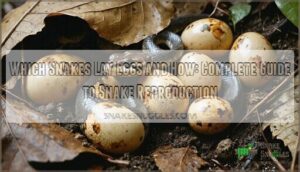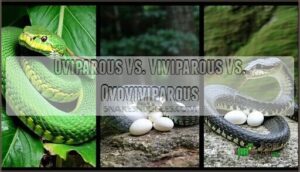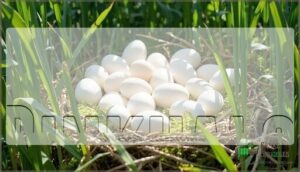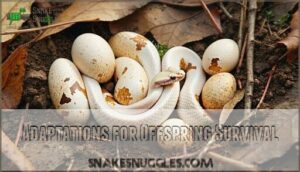This site is supported by our readers. We may earn a commission, at no cost to you, if you purchase through links.

Oviparous snakes like pythons, corn snakes, and king snakes lay leathery eggs in hidden spots, leaving them to develop on their own.
These eggs aren’t hard like bird eggs – they’re flexible and absorb moisture from soil or rotting wood.
However, snakes in colder climates often give live birth instead, including garter snakes, water snakes, and most vipers.
This adaptation helps them control temperature better for their babies.
Some species even keep eggs inside their bodies until hatching, combining both methods for maximum survival benefits.
They exhibit oviparous characteristics, but also have the ability to give live birth, making them highly adaptable creatures, with some species showing reproductive strategies that enhance their offspring’s chances of survival.
Table Of Contents
- Key Takeaways
- Which Snakes Lay Eggs and How?
- Oviparous Vs. Viviparous Vs. Ovoviviparous
- Snakes That Lay Eggs
- Snakes That Give Live Birth
- Adaptations for Offspring Survival
- Evolution of Live Bearing Snakes
- Frequently Asked Questions (FAQs)
- Which snakes give birth and which lay eggs?
- What to do if you find snake eggs in your yard?
- Can a snake lay eggs without mating?
- Do any venomous snakes lay eggs?
- Which venomous snake lays eggs?
- Do female snakes lay eggs without a male?
- Where do snakes go after laying eggs?
- What type of snake does not lay eggs?
- How long can snake eggs survive without incubation?
- Can snakes lay unfertilized eggs like chickens?
- Conclusion
Key Takeaways
- You’ll find that 70% of snake species lay eggs – including pythons, corn snakes, and cobras – while the remaining 30% give birth to live young, like boas and rattlesnakes, with each method perfectly adapted to their environment.
- Snake eggs aren’t like bird eggs – they’re leathery, flexible shells that absorb moisture from soil or rotting wood, and most mothers abandon them immediately after laying, though pythons are rare exceptions that coil around their clutch for warmth.
- Cold climate snakes typically give live birth – species like garter snakes, water snakes, and vipers use this strategy because it helps them better control the temperature for their babies’ survival in harsh conditions.
- Some snakes use a hybrid approach called ovoviviparity – they keep eggs inside their bodies until hatching, combining the benefits of both egg-laying and live birth to maximize their offspring’s survival chances.
Which Snakes Lay Eggs and How?
When you think about snake reproduction, about 70% of species are oviparous, meaning they lay eggs rather than giving live birth.
These snake eggs come in various sizes and shapes, with some having sticky coatings that help secure them to nesting sites.
The snake egg laying process involves females depositing their clutch in protected locations like rotting logs or sandy burrows.
Egg incubation periods vary by species and temperature, with some mothers providing parental care through coiling behavior for warmth.
Fertilization initiates egg accumulation in glands that create protective layers.
Oviparous Vs. Viviparous Vs. Ovoviviparous
Snake reproduction falls into three distinct categories that’ll help you understand how these fascinating creatures bring their young into the world.
Oviparous snakes lay eggs outside their bodies, requiring egg incubation in external environments.
Viviparous snakes give birth to live young, providing placental nourishment directly to developing embryos.
Ovoviviparous snakes combine both methods through internal hatching, where eggs develop inside the mother’s body before birth.
| Reproduction Type | Development Location | Birth Method |
|---|---|---|
| Oviparous | External eggs | Hatching from shells |
| Viviparous | Inside mother’s body | Live birth with placenta |
| Ovoviviparous | Internal eggs | Live birth after internal hatching |
| Climate Adaptation | Varies by environment | Temperature-dependent |
| Reproductive Advantages | Energy efficiency | Survival optimization |
Each method offers specific reproductive advantages based on environmental conditions and climate adaptation needs.
You’ll find that egglaying snakes dominate warmer regions, while live-bearing species thrive in cooler climates where external incubation becomes challenging.
Snakes That Lay Eggs
Most snakes you’ll encounter in the wild are oviparous, meaning they lay eggs rather than giving birth to live young.
About seventy percent of all snake species, including pythons, cobras, and corn snakes, deposit their eggs in protected locations where the embryos develop outside the mother’s body.
Most snakes are dedicated mothers, carefully choosing safe hideaways like rotting logs and sandy burrows for their precious eggs.
Rinkhals
Among African snakes, you’ll find Rinkhals stand out as fascinating egg-laying species with remarkable adaptations.
Their reproductive strategy includes several key features:
- Small clutch size of 20-35 eggs per breeding cycle
- Leathery shell texture that blends with surrounding vegetation
- Strategic nesting in protected grassland microenvironments
- Temperature-dependent incubation lasting 3-4 months
These oviparous snakes produce small, leathery eggs perfectly designed for camouflage in their grassland habitat.
Unlike most cobras, Rinkhals choose egg-laying over live birth, making them unique in snake reproduction.
This egg-laying approach helps Rinkhals thrive across southern Africa’s diverse landscapes.
Some enthusiasts even purchase Rinkhals eggs for various purposes.
Sea Snakes
While most sea snakes give birth to live young underwater, you’ll find fascinating exceptions in the Laticauda genus. These oviparous snakes must return to land for snake reproduction, making them unique among marine species.
Their snake eggs require careful incubation in coastal habitats across the Indo-Pacific region.
Here’s what makes these egg-laying sea snakes remarkable:
- Venom potency rivals the deadliest terrestrial species, perfectly adapted for hunting fish
- Females travel significant distances to find suitable nesting sites on shore
- Conservation efforts focus heavily on protecting their critical breeding beaches
- Snake egg incubation occurs in warm sand or rocky crevices near the ocean
- They’re the only sea snakes that maintain this ancient reproductive strategy
Interestingly, females exhibit control over frequency of reproduction.
Snakes That Give Live Birth
You’ll find that about 30% of snake species give birth to live young instead of laying eggs, including water snakes, garter snakes, and boa constrictors.
These snakes develop their babies inside their bodies, and the young emerge fully formed and ready to survive on their own, which is a unique characteristic of certain species like boa constrictors.
Water Snakes
You’ll find water snakes breaking the typical snake reproduction pattern by giving live birth instead of laying eggs.
Water snakes defy expectations – these aquatic hunters give birth to fully-formed babies instead of laying vulnerable eggs.
These aquatic species incubate their young internally within thin, leathery membranes. Their habitat demands this adaptation – underwater egg laying would be impossible.
Water snakes’ behavior includes delivering fully-formed hatchlings ready for aquatic life. Their diet of fish and frogs supports this reproductive strategy, unlike oviparous snakes that must find suitable nesting sites.
Some snakes utilize ovoviviparity reproduction where eggs hatch internally.
Garter Snakes
Unlike oviparous snakes that lay snake eggs, garter snakes give birth to live young through viviparity. These adaptable reptiles thrive across diverse Garter Habitats, from grasslands to forests, where their varied Garter Diets include small fish, amphibians, and insects.
Their fascinating Garter Behavior includes communal hibernation and spring mating rituals.
Here’s what makes garter snake reproduction remarkable:
- Females carry developing embryos internally without laying eggs
- Gestation periods last 2-3 months depending on climate
- Litters range from 10-40 babies born fully independent
- Newborns measure 5-9 inches and hunt immediately
- Garter Conservation efforts protect essential breeding habitats
This live birth strategy helps them avoid Garter Predation risks during vulnerable egg stages, and is a key aspect of their adaptability and unique reproduction method.
Boa Constrictors
Boa constrictors showcase fascinating snake reproduction through viviparity.
These Boidae family members don’t produce snake eggs like many species. Instead, they give birth to fully formed live young after internal development.
Here’s what makes boa breeding unique:
- Embryos develop inside the mother’s body with placental connections
- Litter sizes range from 10 to 60 offspring depending on the female’s size
- Newborns measure 14-22 inches long and hunt immediately after birth
- Gestation periods last approximately 100-120 days before delivery
Adaptations for Offspring Survival
Survival strategies for snake offspring reveal nature’s remarkable ingenuity.
Nest site selection plays a vital role, as females choose warm, protected locations for ideal snake egg development.
Eggshell camouflage helps conceal clutches from predators, while incubation strategies vary by species.
Pythons demonstrate parental investment by coiling around their snake eggs, maintaining proper temperature.
Most species, however, prioritize hatchling independence – newborns emerge fully equipped with fangs and hunting instincts.
These adaptations guarantee snake reproduction success, with each strategy perfectly suited to the species’ environmental challenges and survival needs.
Evolution of Live Bearing Snakes
Live birth in snakes didn’t happen overnight. Viviparity Origins trace back to over 30 independent evolutionary events, showing how Climatic Adaptation drove these changes.
Cold environments favored viviparous snakes because mothers could regulate their offspring’s temperature better than abandoned eggs. Genetic Factors triggered complex anatomical shifts in Reproductive Strategies.
Remarkably, some Boa Re-evolution shows certain lineages returned to egg-laying after millions of years of live birth. This flexibility in snake evolution demonstrates how reptile reproduction adapts to environmental pressures, helping livebearing snakes colonize diverse habitats worldwide.
These adaptations exemplify body shape changes seen across species.
Frequently Asked Questions (FAQs)
Which snakes give birth and which lay eggs?
About 70% of snakes lay eggs, including pythons, corn snakes, and cobras. The remaining 30% give live birth, like boas, rattlesnakes, and most sea snakes. You’ll find egg-layers more common worldwide.
What to do if you find snake eggs in your yard?
Finding unexpected oval treasures in your backyard can spark both curiosity and concern.
Don’t disturb the eggs—most belong to harmless species.
Contact local wildlife authorities for identification and safe removal if needed, as this will ensure the well-being of both you and the wildlife.
Can a snake lay eggs without mating?
Yes, female snakes can produce unfertilized eggs through parthenogenesis, though it’s rare.
However, stored sperm from previous matings can remain viable for years, allowing fertilized egg production long after the initial encounter, which involves previous matings.
Do any venomous snakes lay eggs?
Several venomous snakes lay eggs, including cobras, mambas, adders, and coral snakes. However, most North American venomous species like rattlesnakes and copperheads give birth to live young instead.
Which venomous snake lays eggs?
Coral snakes are the primary venomous egg-layers you’ll encounter in North America, found in Arizona, Texas, Florida, and the Carolinas. Most other venomous species like rattlesnakes give live birth instead.
Do female snakes lay eggs without a male?
Female snakes can’t lay fertile eggs without mating with a male first. However, they’ll sometimes produce infertile eggs through a process called parthenogenesis, but these won’t hatch into baby snakes.
Where do snakes go after laying eggs?
Most female snakes abandon their eggs immediately after laying them, leaving the nest site to resume normal activities.
They don’t provide parental care, though pythons and king cobras are rare exceptions that guard their clutches.
What type of snake does not lay eggs?
You’ve probably wondered if all snakes abandon their eggs in hidden spots.
Actually, viviparous snakes like boas, rattlesnakes, and most sea snakes don’t lay eggs at all—they give birth to live young instead.
How long can snake eggs survive without incubation?
Snake eggs can’t survive long without proper incubation – typically just a few days at room temperature before dying.
You’ll need consistent warmth and humidity within 24-48 hours for viable hatching success.
Can snakes lay unfertilized eggs like chickens?
Like nature’s lottery tickets, you’ll rarely find snake eggs that won’t hatch.
Unlike chickens, snakes don’t typically lay unfertilized eggs.
Their reproductive system efficiently prevents this waste, making every egg count.
Conclusion
Understanding which snakes lay eggs and how they reproduce opens a fascinating window into nature’s adaptability.
You’ve discovered that snakes use three distinct reproductive strategies, each perfectly suited to their environment and survival needs.
From pythons depositing leathery eggs in warm hideaways to garter snakes delivering live young in harsh climates, these reptiles showcase remarkable evolutionary solutions.
Whether you’re a reptile enthusiast or curious naturalist, recognizing these reproductive patterns helps you appreciate the incredible diversity within the snake world, and understand the reproductive strategies they employ.
- https://timesofindia.indiatimes.com/etimes/trending/how-do-snakes-reproduce-ovoviviparity-will-leave-you-amazed/articleshow/116212901.cms
- https://www.geeksforgeeks.org/snake-life-cycle/
- https://www.britannica.com/animal/snake/Egg-formation-and-laying
- https://www.quora.com/Are-all-snake-species-either-oviparous-or-viviparous-Are-there-any-other-options-besides-these-two
- https://a-z-animals.com/animals/snake/snake-facts/snake-eggs/













